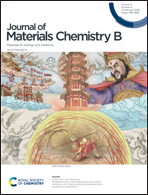Synthesis and antibacterial properties of fluorinated biodegradable cationic polyesters†
Abstract
Antimicrobial peptide-mimicking antibacterial polymers represent a practical strategy to conquer the ever-growing threat of antimicrobial resistance. Herein, we report the syntheses and antibacterial performance of degradable amphiphilic cationic polyesters containing pendent quaternary ammonium motifs and hydrophobic alkyl or fluoroalkyl groups. These polyesters were conveniently prepared from poly(3-methylene-1,5-dioxepan-2-one) via highly efficient one-pot successive thiol-Michael addition reactions. The antibacterial activity of these polyesters against S. aureus and E. coli and their hemolytic activity toward red blood cells were evaluated; some of them showed moderate antibacterial activity and selectivity against Gram-positive S. aureus. The membrane disruption mechanism of these cationic polyesters was briefly explored by monitoring the bacteria killing kinetics and SEM observations. Moreover, the effects of cationic/hydrophobic ratio and the incorporation of fluoroalkyl groups on the antibacterial activity and selectivity of the polyesters were demonstrated.



 Please wait while we load your content...
Please wait while we load your content...